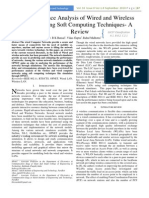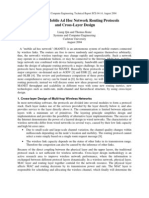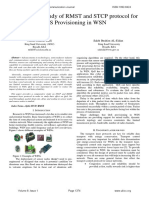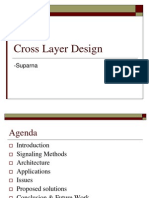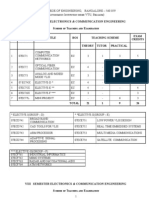IJRECE performanceanalysisofAODV Published
IJRECE performanceanalysisofAODV Published
Uploaded by
GJ GNANA VENKAT NAGCopyright:
Available Formats
IJRECE performanceanalysisofAODV Published
IJRECE performanceanalysisofAODV Published
Uploaded by
GJ GNANA VENKAT NAGOriginal Title
Copyright
Available Formats
Share this document
Did you find this document useful?
Is this content inappropriate?
Copyright:
Available Formats
IJRECE performanceanalysisofAODV Published
IJRECE performanceanalysisofAODV Published
Uploaded by
GJ GNANA VENKAT NAGCopyright:
Available Formats
See discussions, stats, and author profiles for this publication at: https://www.researchgate.
net/publication/324861161
Performance Analysis of AODV Routing protocol in Optical Underwater Sensor
Network
Research · May 2018
DOI: 10.13140/RG.2.2.30395.52009
CITATIONS READS
2 292
3 authors, including:
Divya Khandelwal Deepak Bagai
PEC University of Technology PEC University of Technology
4 PUBLICATIONS 6 CITATIONS 25 PUBLICATIONS 132 CITATIONS
SEE PROFILE SEE PROFILE
Some of the authors of this publication are also working on these related projects:
Opto-Acoustic Underwater Wireless Sensor Network View project
All content following this page was uploaded by Divya Khandelwal on 06 May 2018.
The user has requested enhancement of the downloaded file.
IJRECE VOL. 6 ISSUE 2 APR.-JUNE 2018 ISSN: 2393-9028 (PRINT) | ISSN: 2348-2281 (ONLINE)
Performance Analysis of AODV Routing protocol in
Optical Underwater Sensor Network
Divya Khandelwal, Rita Mahajan, Deepak Bagai
Abstract— Underwater Wireless Sensor Network have Application Layer: The Application Layer is responsible for
applications in Marine Monitoring, Seismic Surveillance, traffic generation and application level routing. Protocols
Underwater environment pollution control and various others. written at the Application Layer rely on the Transport Layer
In this work we have used a commercial software, Qualnet, to deliver application-level data from the source to the
which is a discrete event simulator, to simulate a simple destination. Application Layer protocols implemented in
network to analyze parameters like average jitter, end-to-end QualNet are Constant Bit Rate (CBR), FTP, and Telnet.
delay etc. for the same. The parameters are analyzed for a Examples of Application Layer routing protocols
network of 100 nodes. The data is routed according to the implemented in QualNet are RIP, Bellman-Ford, and BGP.
AODV routing protocol of the network layer and the physical
layer is customized with parameters to work with optical links Transport Layer: The Transport Layer provides end-to-end
with various data rates for underwater settings. data transmission services to the Application Layer.
Protocols written at the Transport Layer receive data from the
Keywords—Underwater Optical Communication, Application Layer and rely on the Network Layer for data
Underwater channel modelling, AODV, Qualnet Simulator 5.0 forwarding at the source node, and receive data from the
Network Layer and pass data to the Application Layer at the
I. INTRODUCTION destination node. Examples of Transport Layer protocols
The Underwater Communication poses different challenges as include UDP, TCP and RSVP-TE.
compared to the communication in terrestrial sensor networks
due to harsh environmental settings. While RF can be used as a Network Layer: The Network Layer is responsible for data
communication link on the land, it is highly attenuated inside forwarding and queuing/scheduling. The Internet Protocol
water, thereby not feasible. Currently the most mature (IP) resides at this layer and is responsible for packet
technology for the marine environment is the acoustic mode of forwarding. Examples of Network Layer routing protocols
communication, but it also poses limitations like low data rate implemented in QualNet are AODV, DSR, OSPF, and
[1]. So, to send heavy data like videos, audios etc. optical links DVMRP.
are being explored which provide the benefit of higher data
rates and faster communication though in a small range [2-11]. MAC Layer: The Link (MAC) Layer provides link-by-link
To study the performance of a network, we use Qualnet 5.0 as transmission. Examples of protocols at the Link (MAC)
our simulator out of all the various simulators which are Layer implemented in QualNet are point-to-point, IEEE
available. Since underwater environment are not compatible 802.3, IEEE 802.11, and CSMA.
with built-in protocols of Qualnet protocol stack, we attempt to
model the underwater channel for optical links and modify the Physical Layer: The Physical Layer is responsible for
Qualnet version 5.0 to work with the same scenario. transmitting and receiving raw bits from the wired and
Subsequently study the performance of AODV routing protocol wireless channel.
on that network.
Communication Medium: The communication medium
II. WORKING ENVIRONMENT transmits signals between nodes. In QualNet, a
communication medium model has three components: a path
A. Qualnet 5.0 Simulator loss model, a fading model, and a shadowing model. Path loss
models in QualNet include Free Space, Two Ray, and
QualNet is a network simulator which provides a Irregular Terrain Model (ITM). QualNet implements the
comprehensive environment for designing protocols, creating Ricean fading model. Rayleigh fading is a special case of
and animating network scenarios, and analyzing their Ricean fading. QualNet provides models for two shadowing
performance. It also provides a set of tools with all the models: constant and lognormal.
components for developing a custom network and for its B. Network architecture and Specifications
reliable simulation. QualNet has significantly higher speed,
The sensor network is architectured using the GUI of the
better scalability and fidelity as compared to other network
Qualnet and its properties are specified in Table I. The
simulators[10]. Its works with a protocol stack which includes
complete network is placed onto a cartesian coordinate plane
the following layers:
i.e 200 × 200 has altitude ranging from 0 m above sea level to
INTERNATIONAL JOURNAL OF RESEARCH IN ELECTRONICS AND COMPUTER ENGINEERING
A UNIT OF I2OR 105 | P a g e
IJRECE VOL. 6 ISSUE 2 APR.-JUNE 2018 ISSN: 2393-9028 (PRINT) | ISSN: 2348-2281 (ONLINE)
100 m below sea level. One optical channel is considered for
communication and its frequency is given as 560 THz, since
it is the frequency of green light (λ=490 nm) which is
generally used as the source LED in pure sea and clear ocean
[11]. The modelling of communication medium is done by
specifying Pathloss, Shadowing and Fading Model. For our
work, we have chosen Fading model as ‘Ricean model’,
Pathloss model as ‘Two Ray’ model and the shadowing
model as ‘None’. According to the results from [11], we
choose the Maximum Propagation Distance which is the
maximum distance for which a node’s transmission is
considered for communication, as 50m. Similarly, for
medium speed optical communication i.e 1-2 Mbps, [6] states
that the communication distance is 30-60 m. Therefore, we
take the propagation communication proximity, which is the Fig. 2 Network Architecture with 100 nodes in 3D
approximate optimistic optical communication range, as
40m. The nodes are specified with the parameters mentioned in
Table-I. All the nodes are randomly placed on the cartesian
Mobility model is considered as the nodes in the water body are plane resembling the real time scenario, connected in a wireless
subjected to movement due to the turbulence in the subnet. The communication takes place in this subnet from
environment. Therefore, we take the mobility model as the source node to the destination node. These source and
Random Waypoint model. The corresponding parameters are destination are identified by the CBR links ends. Constant Bit
mentioned in the Table I. We have chosen the position rate (CBR) is an application layer protocol which acts as a
granularity i.e the distance by which node moves 1mm in a traffic generator. It is a UDP based client server application,
single step for a simulation of 5 days. The network works on data is sent from a client to server at a Constant Bit Rate. We
different protocols for different layers. While Network layer have used UDP over TCP as it does not have much overhead
uses IPv4 and MAC layer uses CSMA, the Routing protocol unlike latter, therefore for the resource constrained embedded
chosen is AODV (Ad-Hoc On Demand Distance Vector). designs it is better to be used.
Network architecture consists of 100 nodes. Subsequently, the
parameters of network communication are analyzed for these Table I: Network specifications
networks. The following figure shows the architecture of the
network. 1. Scenario Properties−> General Value
1.a Simulation Time 5 days
1.b Real Time 45 minutes
1.c Background Image GUI image of
water
2. Scenario Properties−> Channel
Properties
2.a Coordinate System Cartesian
X=200m
Y=200m
2.b Altitude Range (in m) Above Sea
level=0
Below Sea
level=100
2.c Weather Mobility Interval 100 msec
2.d Number of Channels 1
2.e Channel Frequency 560 THz
2.f Pathloss Model Two Ray
2.g Shadowing Model None
2. Fading Model Ricean
h
Fig. 1 Network Architecture with 100 nodes in 2D 2.i Propagation limit 16.53 dBm
2.j Maximum Propagation See Table II
INTERNATIONAL JOURNAL OF RESEARCH IN ELECTRONICS AND COMPUTER ENGINEERING
A UNIT OF I2OR 106 | P a g e
IJRECE VOL. 6 ISSUE 2 APR.-JUNE 2018 ISSN: 2393-9028 (PRINT) | ISSN: 2348-2281 (ONLINE)
Distance III. EVALUATED NETWORK MODELS
2.k Propagation Communication See Table II The specifications are used to characterize network considered.
Proximity The effect on the network performance parameters like Average
Jitter and End to End delay. The network has the nodes that
3. Node Properties−> Mobility and make up a subnet with the all the details about each layer and its
Placement protocol specifically defined.
3.a Mobility Waypoint Random
Waypoint Since the transmission power is taken as 20 dBm which is equal
3.b Pause Time 2 min to 0.1 W as it is the lowest value of LED source power [11].
3.c Minimum Speed 0 m/sec Corresponding to this value we calculate the propagation limit
3.d Maximum Speed 0.1 m/sec of the scenario. It is the threshold power below which the signal
3.e Position Granularity 0.001 m is not delivered to the nodes. This parameter is meant for
optimizing the performance. We calculate it using the Beer-
4. Network Layer Protocol IPv4 Lambert’s law as follows.
5. Routing Protocol AODV I(z) = I0 exp (-c()∙z) (1)
6. Subnet Properties−> Physical where,
Layer z = distance from source at which signal power needs to be
6.a Radio Type Abstract calculated = 40 m
6.b Data Rate [6] Case 1: 10 Mbps = wavelength of source light =490 nm (to be used for pure
Case 2: 2 Mbps sea and clear ocean water) [12-13]
Case 3: 100 c()=attenuation coefficient = 0.02 m-1 (for =490 nm)[11]
Kbps I0 = Transmission power of LED= 0.1W
6.c Transmission Power 20 dBm
6.d Reception Sensitivity 0 dBm Therefore, we get 0.045 W= 16.53 dBm.
6.e Reception Threshold -40.76 dBm
6.f Packet Reception Model SNR based At the application layer the CBR is defined between 8 node
Reception pairs to study the network. It defines us the source node of
Model information and the destination node. All the rest nodes are the
6.g SNR threshold 10 dB part of the subnet and may act as hops for the information
transferred.
6. Temperature 305 K
h
Table III: CBR Links
6.i Noise Factor 0 dB
6.j Energy Model Mica-Motes
Source Destination Node Number of
Node Hops
The above data has been taken to construct a network scenario.
Node 7 Node 8 1
Maximum Propagation Distance is the maximum distance for
Node 12 Node 8 1
which a node’s transmission is considered for communication.
Node 22 Node 43 0
Similarly, Propagation Communication Proximity should be set
to the approximate range. Node 60 Node 19 2
Node 64 Node 15 0
Table II: Range based on Transmission Rate Node 86 Node 49 1
Node 92 Node 33 0
Transmissio Maximum Considered Node 100 Node 87 0
n Rate Propagation Propagation
Distance Communication
Proximity [6]
10 Mbps Infinite 30 m
2 Mbps Infinite 50 m
100 Kbps Infinite 80 m
INTERNATIONAL JOURNAL OF RESEARCH IN ELECTRONICS AND COMPUTER ENGINEERING
A UNIT OF I2OR 107 | P a g e
IJRECE VOL. 6 ISSUE 2 APR.-JUNE 2018 ISSN: 2393-9028 (PRINT) | ISSN: 2348-2281 (ONLINE)
Table VII: Case 3: Data Rate = 100 Kbps
Propagation Average Jitter Average End to End
Distance Delay
20 m 0.0018 0.0116
50 m 0.0019 0.019
100 m 0.0019 0.024
150 m 0.0042 0.0368
200 m 0.008 0.054
The above tables show the values of parameters that describe
the link formed between source and destination. The average
jitter and the end to end delay are studied and plotted for various
data rates in Fig 4. and Fig 5.
Fig 3. Information transfer in the subnet
IV. RESULTS AND PERFORMANCE ANALYSIS
We perform the simulation for the network with 8 CBR links
which characterize a constant bit rate route from source to
destination.
The CBR client description is as follows.
Table IV: CBR Client details
Bytes Sent 12000
Packets Sent 24
Throughput (bits/sec) 4000
Corresponding to this we have the CBR server which shows the Fig 4. Average jitter vs propagation distance (range)
parameters i.e. Average jitter and End to End delay of the
nodes.
The CBR server evaluated results are as follows:
Table V: Case 1: Data Rate = 10 Mbps
Propagatio Average Jitter Average End to End
n Distance Delay
20 m 0.0017 0.011
50 m 0.0026 0.024
100 m 0.0058 0.065
150 m 0.0138 0.09
200 m 0.0221 0.13
Table VI: Case 2: Data Rate = 2 Mbps
Propagation Average Jitter Average End to End Fig 5. Average End to End Delay vs propagation distance
Distance Delay (range)
20 m 0.0017 0.012
50 m 0.0019 0.024 V. CONCLUSION
100 m 0.0037 0.038
This paper focuses on analyzing performance parameters of
150 m 0.0088 0.069
an AODV based Optical Underwater Wireless Sensor network.
200 m 0.014 0.098
Previously work have been done to analyze the performance
INTERNATIONAL JOURNAL OF RESEARCH IN ELECTRONICS AND COMPUTER ENGINEERING
A UNIT OF I2OR 108 | P a g e
IJRECE VOL. 6 ISSUE 2 APR.-JUNE 2018 ISSN: 2393-9028 (PRINT) | ISSN: 2348-2281 (ONLINE)
AODV routing protocol in terrestrial network but subjecting it simulation of underwater optical networks," in Proc. MTS/IEEE
to underwater environment helps study it better. Therefore, we Oceans, Aberdeen, Scotland, Jun. 2017
have characterized the network as the underwater sensor
network and then studied the parameters like average jitter and
end to end delay. This has been done for various propagation
distances each for the data rate 10 Mbps, 2 Mbps and 100 kbps.
Studying the results, we can say that as the we increase the
propagation distance the average jitter and the end to end delay Divya Khandelwal Graduate student of Master’s in
increase more rapidly for higher data rates as compared to Technology (Electronics) at Punjab Engineering College,
lower ones. So, we can conclude that, in order to get an Sector-12, Chandigarh. Research Interests are Wireless Sensor
optimized network and an efficient system, we should use Networks, Underwater optical and acoustic communication and
higher data rates for smaller communication range and lower Qualnet Simulator.
data rates for longer range communication range. Since higher
data rates i.e in Mbps mean more information transfer, so when
we need heavy data that is needed to be transferred we can use
short range optical communication.
Dr. Rita Mahajan, Assistant Professor, Phd,
VI. REFERENCES Department of Electronics and Communication Engineering,
[1] Wei, W., Chen, N.N., Zhang, X., Rao, J.H., Wang, W.B., Punjab Engineering College, Sector-12, Chandigarh, Research
Research and survey of wireless optical communication for Interests are Communication,VLSI Design.
underwater wireless sensor networks. Sens. World 17 (3), 6–12,
2011.
[2] I. F. Akyildiz, D. Pompili, and T. Melodia, “Underwater acoustic
sensor networks: Research challenges,” Ad Hoc Netw., vol. 3, no.
3, pp. 257–279, 2005.
Dr. Deepak Bagai, Professor, Phd, Department of
[3] Ahmad, Z.U., 2013. Underwater Optical Wireless Sensor
Electronics and Communication Engineering, Punjab
Network. University of Warwick
[4] H. Kaushal, G. Kaddoum, 2016, “Underwater optical wireless Engineering College, Sector-12, Chandigarh, Research
communication”, IEEE, pp.1518–1547 Interests are Electronic Waste Management, Communication
[5] Seongwon Han, Youngtae Noh, Richard Liang, Roy Systems.
Chen,Yung-Ju Cheng, and Mario Gerla, ,May 2014, "Evaluation
of Underwater Optical-Acoustic Hybrid Network," IEEE China
Communications, 11(5): 49-59.
[6] Jingjing Wang, Wei Shia, Lingwei Xua, Liya Zhoua, Qiuna Niua,
Ju liu, February 2017, “Design of optical-acoustic hybrid
underwater wireless sensor network”, Elsevier Journal of
Network and Computer Applications, Vol.43, pp-45-56
[7] Zhaoquan Zeng, 2015, “A Survey of Underwater Optical
Wireless Communications”, University of British Columbia.
[8] F. Hanson and S. Radic, “High bandwidth underwater optical
communication,” Appl. Opt., vol. 47, no. 2, pp. 277–283, Jan.
2008.
[9] D. Anguita, D. Brizzolara, and G. Parodi, “Building an
underwater wireless sensor network based on optical
communication: Research challenges and current results,” in Int.
Conf. on Sensor Technologies and Applications
(SENSORCOMM), Athens, Greece, Aug. 2009, pp. 476–479.
[10] S. Arnon, “Underwater optical wireless communication
network,” Opt. Eng., vol. 49, no. 1, pp. 1–6, Jan. 2010. Scalable
Network Technology, Inc. QualNet 5.0 Programmer’s Guide. Los
Angeles, CA, September 2009, p. 2-5.
[11] Giles, J.W, Bankman, I.N., October 2005, “Underwater optical
communications systems. Part 2: basic design considerations,”
Military Communications Conference, IEEE, Vol., no.,
pp.1700-1705 Vol. 3, 17-20
[12] K. Shifrin, Physical Optics of Ocean Water. New York: American
Institute of Physics, 1988.
[13] F. Campagnaro, M. Calore, P. Casari, V. S. Calzado, G.
Cupertino, C. Moriconi, and M. Zorzi, "Measurement-based
INTERNATIONAL JOURNAL OF RESEARCH IN ELECTRONICS AND COMPUTER ENGINEERING
A UNIT OF I2OR 109 | P a g e
View publication stats
You might also like
- Concise Guide to OTN optical transport networksFrom EverandConcise Guide to OTN optical transport networksRating: 4 out of 5 stars4/5 (2)
- MKT-210 Midterm Fall 2019 PDFDocument4 pagesMKT-210 Midterm Fall 2019 PDFJacques OwokelNo ratings yet
- Imm1294f PDFDocument1 pageImm1294f PDFVictor RousteauNo ratings yet
- Fortinac: Fortigate Endpoint Management IntegrationDocument41 pagesFortinac: Fortigate Endpoint Management IntegrationAlan Becerra Arrieta100% (1)
- Wavelength Routed Optical NetworksDocument17 pagesWavelength Routed Optical Networksdce_student75% (4)
- 14 Performance Analysis of Wired and Wireless LANDocument5 pages14 Performance Analysis of Wired and Wireless LANSigula Galuh0% (1)
- Vdocuments - MX - Demystifying SDN For Optical Transport Networks Real Demystifying SDN ForDocument7 pagesVdocuments - MX - Demystifying SDN For Optical Transport Networks Real Demystifying SDN Forduy nguyen khanhNo ratings yet
- Performance Evaluation of Wired and Wireless Local Area NetworksDocument6 pagesPerformance Evaluation of Wired and Wireless Local Area NetworksIJERDNo ratings yet
- A Comparative Study of AODV, DSR, and DYMO Routing Protocols Using OMNeTDocument5 pagesA Comparative Study of AODV, DSR, and DYMO Routing Protocols Using OMNeTEditor IJRITCCNo ratings yet
- Abstract: Due To Significant Advances in Wireless Modulation Technologies, Some MAC Standards Such As 802.11aDocument6 pagesAbstract: Due To Significant Advances in Wireless Modulation Technologies, Some MAC Standards Such As 802.11aVidvek InfoTechNo ratings yet
- Network Model Analysis in Opnet Simulation: Electronic Transfer of Data and or InformationDocument5 pagesNetwork Model Analysis in Opnet Simulation: Electronic Transfer of Data and or InformationsanketNo ratings yet
- Wireless Sensor Network Architecture: April 2011Document6 pagesWireless Sensor Network Architecture: April 2011sskNo ratings yet
- Analysis of Behavior of MAC Protocol and Simulation of Different MAC Protocol and Proposal Protocol For Wireless Sensor NetworkDocument7 pagesAnalysis of Behavior of MAC Protocol and Simulation of Different MAC Protocol and Proposal Protocol For Wireless Sensor NetworkAnkit MayurNo ratings yet
- Versatile Low Power Media Access For Wireless Sensor NetworksDocument13 pagesVersatile Low Power Media Access For Wireless Sensor NetworksVenkat SivaNo ratings yet
- CCN OelDocument7 pagesCCN OelAbdul ShakoorNo ratings yet
- The Application of A Wireless Sensor Network Design Based On Zigbee in Petrochemical Industry FieldDocument4 pagesThe Application of A Wireless Sensor Network Design Based On Zigbee in Petrochemical Industry FieldThi AgoNo ratings yet
- Computer NetworksDocument139 pagesComputer NetworksniharikaNo ratings yet
- Comparative Analysis of Performance of Hub With Switch Local Area Network (LAN) Using Riverbed in University of Technology (Utech), JamaicaDocument23 pagesComparative Analysis of Performance of Hub With Switch Local Area Network (LAN) Using Riverbed in University of Technology (Utech), JamaicaOla Yemi UthmanNo ratings yet
- A Comparative Study of AODV, DSR, and DYMO Routing Protocols Using OMNeT++Document5 pagesA Comparative Study of AODV, DSR, and DYMO Routing Protocols Using OMNeT++hhakim32No ratings yet
- Performance Evaluation of Zigbee Protocol Using Opnet Modeler For Mine SafetyDocument5 pagesPerformance Evaluation of Zigbee Protocol Using Opnet Modeler For Mine SafetyijcsnNo ratings yet
- A Cost-Efficient Transceiver Prototype For Arduino-Based Laser CommunicationDocument6 pagesA Cost-Efficient Transceiver Prototype For Arduino-Based Laser CommunicationKamen KaloqnkovNo ratings yet
- Report Ip Over WDMDocument16 pagesReport Ip Over WDMGunawanNo ratings yet
- Frame Work For DesignexpDocument15 pagesFrame Work For DesignexplokeshNo ratings yet
- Thivya Bharathi.R, Sridivya.N: Random Access Live and Pre Recorded Streaming and NDNDocument5 pagesThivya Bharathi.R, Sridivya.N: Random Access Live and Pre Recorded Streaming and NDNarun sivaNo ratings yet
- Kim Wbonding 2Document5 pagesKim Wbonding 2cintasatumalamNo ratings yet
- Sensors 20 05464 v2Document22 pagesSensors 20 05464 v2Hoàng VõNo ratings yet
- Versatile Low Power Media Access For Wireless Sensor NetworksDocument13 pagesVersatile Low Power Media Access For Wireless Sensor NetworksHarsha KuntamukkalaNo ratings yet
- Final Computer Network Lab Mannual (18ECL76)Document99 pagesFinal Computer Network Lab Mannual (18ECL76)Ankushh RNo ratings yet
- Opnet ResearchDocument7 pagesOpnet Researchhossam80No ratings yet
- Rajalakshmi Engineering CollegeDocument17 pagesRajalakshmi Engineering Collegechituuu100% (2)
- Enhanced Constraint-Based Optical Network For Improving OSNR Using ROADMDocument10 pagesEnhanced Constraint-Based Optical Network For Improving OSNR Using ROADMInternational Journal of Application or Innovation in Engineering & ManagementNo ratings yet
- Title: Wimax Network Model Performance Testing Using Ns3 Simulation SoftwareDocument8 pagesTitle: Wimax Network Model Performance Testing Using Ns3 Simulation SoftwareInternational Journal of Application or Innovation in Engineering & ManagementNo ratings yet
- IP Over Optical Network Strategy of DeplDocument6 pagesIP Over Optical Network Strategy of Deplasifusmani19No ratings yet
- Survey On Mobile Ad Hoc Network Routing Protocols and Cross-Layer DesignDocument26 pagesSurvey On Mobile Ad Hoc Network Routing Protocols and Cross-Layer DesignvjrathiNo ratings yet
- Elastinet Optical SDN WPDocument8 pagesElastinet Optical SDN WPAnandhNo ratings yet
- Manet Thesis 99marDocument5 pagesManet Thesis 99marRaj Kumar YadavNo ratings yet
- Five Year SolutionsDocument99 pagesFive Year Solutionsamrita tiwariNo ratings yet
- Design of Sensor Nodes in Underwater Sensor Networks: Yu Yang, Zhang Xiaomin, Peng BO, Fu YujingDocument5 pagesDesign of Sensor Nodes in Underwater Sensor Networks: Yu Yang, Zhang Xiaomin, Peng BO, Fu Yujinghari9923No ratings yet
- Elastic Optical Networking in The Microsoft Cloud (Invited)Document10 pagesElastic Optical Networking in The Microsoft Cloud (Invited)Siva Rama KrishnaNo ratings yet
- Unni (-) For Lec-03-Long-Rage-WifiDocument6 pagesUnni (-) For Lec-03-Long-Rage-WifiisaanisaanNo ratings yet
- Architectures and ProtocolsDocument17 pagesArchitectures and ProtocolsParag MahajaniNo ratings yet
- Secure and Configurable Private NetworkDocument54 pagesSecure and Configurable Private NetworkAdil AnsariNo ratings yet
- Traffic Modeling of LTE Mobile Broadband Network Based On NS-2 SimulatorDocument7 pagesTraffic Modeling of LTE Mobile Broadband Network Based On NS-2 SimulatorRaul MarquezNo ratings yet
- 1 PBDocument10 pages1 PBYusuf Raja TambaNo ratings yet
- How Far Can We Go? Towards Realistic Software-De Fined Wireless Networking ExperimentsDocument14 pagesHow Far Can We Go? Towards Realistic Software-De Fined Wireless Networking ExperimentsNam VũNo ratings yet
- Scaling Star-Coupler-Based Optical Networks For Avionics ApplicationsDocument12 pagesScaling Star-Coupler-Based Optical Networks For Avionics ApplicationsqwentionNo ratings yet
- All-Optical VPN Utilizing Dsp-Based Digital Orthogonal Filters Access For PonsDocument10 pagesAll-Optical VPN Utilizing Dsp-Based Digital Orthogonal Filters Access For PonsChit Su HlaingNo ratings yet
- Final DOC ProjectDocument103 pagesFinal DOC ProjectAbdul Wahid100% (1)
- Interference Aware Routing in Multi-Radio Wireless Mesh NetworksDocument9 pagesInterference Aware Routing in Multi-Radio Wireless Mesh NetworksMesmer88No ratings yet
- Comparative Study of RMST and STCP Protocol For Qos Provisioning in WSNDocument6 pagesComparative Study of RMST and STCP Protocol For Qos Provisioning in WSNUbiquitous Computing and Communication JournalNo ratings yet
- Cross Layer Design PPT 4985Document47 pagesCross Layer Design PPT 4985vstamilmaniNo ratings yet
- Reconfigurable Optical-Radio Wireless Networks: Meeting The Most Stringent Requirements of Future Communication SystemsDocument15 pagesReconfigurable Optical-Radio Wireless Networks: Meeting The Most Stringent Requirements of Future Communication Systemsghghg bhbbhbhNo ratings yet
- Communication System and Digital Network 2 City and Guilds Syllabus T3Document13 pagesCommunication System and Digital Network 2 City and Guilds Syllabus T3tchadza100% (1)
- Abbas 2020Document6 pagesAbbas 2020guruprasathrNo ratings yet
- V4i1 Ijertv4is010183Document5 pagesV4i1 Ijertv4is010183Arun RajNo ratings yet
- A Study of Routing Protocols For Ad-Hoc NetworkDocument6 pagesA Study of Routing Protocols For Ad-Hoc NetworkeditorijaiemNo ratings yet
- Trellis CodedDocument8 pagesTrellis CodedMiltonThitswaloNo ratings yet
- Assignment ACNDocument7 pagesAssignment ACNMukeshNo ratings yet
- Acn 2017Document23 pagesAcn 2017shraddha_mundadadaNo ratings yet
- Latency and Bit-Error-Rate Evaluation For Radio-Over-Ethernet in Optical Fiber Front-Haul NetworksDocument9 pagesLatency and Bit-Error-Rate Evaluation For Radio-Over-Ethernet in Optical Fiber Front-Haul NetworksSeema ChauhanNo ratings yet
- 7th & 8th Sem SyllabusDocument33 pages7th & 8th Sem SyllabusAkshay BharadwajNo ratings yet
- Aodv Protocol ThesisDocument4 pagesAodv Protocol ThesisSarah MarieNo ratings yet
- Vehcom BC For UavDocument28 pagesVehcom BC For UavGJ GNANA VENKAT NAGNo ratings yet
- A Survey of Routing Protocols For Underwater Wireless Sensor NetworksDocument24 pagesA Survey of Routing Protocols For Underwater Wireless Sensor NetworksGJ GNANA VENKAT NAGNo ratings yet
- Underwater CommsDocument11 pagesUnderwater CommsGJ GNANA VENKAT NAGNo ratings yet
- 2018 Official Rules of Indoor Cricket - WICF FinalDocument31 pages2018 Official Rules of Indoor Cricket - WICF FinalGJ GNANA VENKAT NAGNo ratings yet
- Box Cricket RulesDocument1 pageBox Cricket RulesGJ GNANA VENKAT NAGNo ratings yet
- Vinjamuri HarikaDocument2 pagesVinjamuri HarikaDattu DattuNo ratings yet
- Grade 10 History Notes - 759606107 - PDF - Telecommunications Engineering - RadioDocument171 pagesGrade 10 History Notes - 759606107 - PDF - Telecommunications Engineering - Radiohussainhusna262No ratings yet
- CCC MCQ Test 2Document21 pagesCCC MCQ Test 2Pooja SinghNo ratings yet
- Zscaler Internet Access Ela PDFDocument2 pagesZscaler Internet Access Ela PDFmohan1233No ratings yet
- RackWare RMM v7.4 Installation Guide v3.14Document15 pagesRackWare RMM v7.4 Installation Guide v3.14HomerodePaulaNo ratings yet
- Nse5 Faz-7.0Document80 pagesNse5 Faz-7.0tareqNo ratings yet
- Lab01 Itt557Document6 pagesLab01 Itt557fatin HumairaNo ratings yet
- (3 7 1) - 爬虫小项目Document5 pages(3 7 1) - 爬虫小项目Pandeng LiNo ratings yet
- Saketha Final ReportDocument44 pagesSaketha Final ReportSaketha NemaniNo ratings yet
- Top Sites To Buy Verified Wise Accounts (Personal and Business)Document21 pagesTop Sites To Buy Verified Wise Accounts (Personal and Business)slj12912100% (1)
- Learning Resource Portal Ver 1Document31 pagesLearning Resource Portal Ver 1janette riveraNo ratings yet
- Servicenow Csa GuideDocument15 pagesServicenow Csa GuideRaju0% (1)
- Athena Global ConsultingDocument8 pagesAthena Global ConsultingKhiet PhamNo ratings yet
- User Manual of NC-AP224Document23 pagesUser Manual of NC-AP224Didin ZaNo ratings yet
- Moodle FCC HomeworkDocument7 pagesMoodle FCC Homeworkafmssihaa100% (1)
- SFDC NoteBook - Trigger Scenario QuestionsDocument10 pagesSFDC NoteBook - Trigger Scenario QuestionsAditya TiwariNo ratings yet
- Communicating CSR On Social Media PfizerDocument13 pagesCommunicating CSR On Social Media PfizerJuliana CabreraNo ratings yet
- Ipv4 Addressing: © 2008 Cisco Systems, Inc. All Rights Reserved. Cisco Confidential Presentation - IdDocument35 pagesIpv4 Addressing: © 2008 Cisco Systems, Inc. All Rights Reserved. Cisco Confidential Presentation - IdPFENo ratings yet
- Satellite 6 Component Versions - Red Hat Customer PortalDocument11 pagesSatellite 6 Component Versions - Red Hat Customer Portalgus2 eiffelNo ratings yet
- American Samoa Government: Department of Health Information Technology (IT) DivisionDocument2 pagesAmerican Samoa Government: Department of Health Information Technology (IT) DivisionDennis GallardoNo ratings yet
- PPPOE ExpiredDocument2 pagesPPPOE ExpiredkamaanetworksNo ratings yet
- Seminar ReportDocument34 pagesSeminar ReportAbdulrahman Lawal YusufNo ratings yet
- ACOS 4.1.1-P11 Configuring VRRP-A High Availability: For A10 Thunder Series and AX™ Series 29 May 2019Document182 pagesACOS 4.1.1-P11 Configuring VRRP-A High Availability: For A10 Thunder Series and AX™ Series 29 May 2019ahilusuaNo ratings yet
- Raja 79% PDFDocument9 pagesRaja 79% PDFamer zerekNo ratings yet
- WinCC Communication en-US en-USDocument760 pagesWinCC Communication en-US en-USŁukasz KrzesińskiNo ratings yet
- Assignment 1Document9 pagesAssignment 1DavidTumini OgoloNo ratings yet
- 335041-TIS TD CCCv2Document27 pages335041-TIS TD CCCv2Vijju Vijayendra PSNo ratings yet






